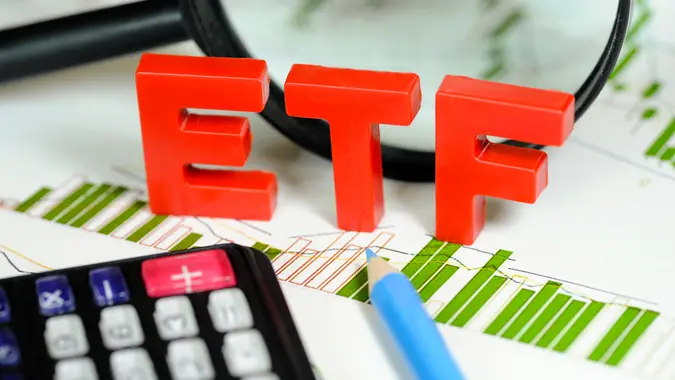Best Energy ETFs To Buy for 2025

Commitment to Our Readers
GOBankingRates' editorial team is committed to bringing you unbiased reviews and information. We use data-driven methodologies to evaluate financial products and services - our reviews and ratings are not influenced by advertisers. You can read more about our editorial guidelines and our products and services review methodology.

20 Years
Helping You Live Richer

Reviewed
by Experts

Trusted by
Millions of Readers
Exchange-traded funds (ETFs) invest in securities based on a specific index, sector, commodity or other category of assets. Therefore, an energy ETF focuses on energy-related securities, such as oil, gas or clean energy companies.
Trending Now: Over 3 in 4 Americans Think Tariffs Will Push Energy Prices Higher: What That Means for Your Wallet
After underperforming the S&P 500 index in 2024, investors are hoping for a bounce back in 2025 and beyond. Thus far, most energy ETFs are indeed outperforming the S&P 500, as their ample dividends provide a bit of a safe haven during uncertain times. However, most are still trading at a loss as of Apr. 23, 2025.
Best Energy ETFs in 2025
Here’s a look at some of the top ETFs to consider in 2025.
1. Energy Select Sector SPDR Fund (XLE)
- Price: $81.24
- Yield: 3.06%
- 3-year return rate: 5.95%
- Expense ratio: 0.08%
- Assets under management: $26.67 billion
- Top holdings: Exxon Mobile, Chevron, ConocoPhillips, Williams Cos, EOG Resources
The Energy Select Sector SPDR Fund represents 23 companies from the S&P 500 that belong to the oil, gas and consumable fuels or energy equipment and services industries.
Some of the fund’s top holdings include blue-chip stocks. Of 60 energy ETFs currently traded on U.S. markets, the Energy Select Sector SPDR Fund is the largest, according to ETF.com. It also has one of the lowest expense ratios, second only to the Fidelity MSCI Energy Index ETF, which also is included in this roundup.
So far in 2025, XLE has a return of -5.16%
2. Invesco S&P 500 Equal Weight Energy ETF (RSPG)
- Price: $70.61
- Yield: 2.38%
- 3-year return rate: 5.0%
- Expense ratio: 0.40%
- Assets under management: $429.1 million
- Top 5 holdings: Williams, Kinder Morgan, Exxon Mobil, EQT, Texas Pacific Land
This ETF holds companies from the S&P 500 Equal Weight Energy Plus Index. Each company in the index is weighted equally at 0.2%. About 90% of the fund’s $590.5 million in assets are invested in the stocks included in the index. The VanEck Oil Services ETF is based on the MVIS U.S. Listed Oil Services 25 Index. This index has U.S.-traded companies involved in oil equipment, oil services or oil drilling.
The YTD return of RSPG is -7.53%.
3. VanEck Oil Services ETF (OIH)
- Price: $209.72
- Yield: 2.07%
- 3-year return rate: -8.19%
- Expense ratio: 0.35%
- Assets under management: $896.79 million
- Top 5 holdings: Schlumberger, Baker Hughes, Halliburton, Technipfmc, Tenaris
The VanEck Oil Services ETF is based on the MVIS U.S. Listed Oil Services 25 Index, which tracks U.S.-traded companies involved in oil equipment, services, and drilling. It’s a way to invest in oil by focusing on the companies that support its production. The ETF holds some of the largest, most liquid energy companies — more than 85% are based in the U.S., with the rest located in the Netherlands, U.K., and Bermuda.
OIH’s YTD return is -22.68%.
4. iShares U.S. Oil & Gas Exploration & Production ETF (IEO)
- Price: $81.68
- Yield: 2.43%
- 3-year return rate: 2.51%
- Expense ratio: 0.40%
- Assets under management: $467.26 million
- Top 5 holdings: ConocoPhillips, EOG Resources, Phillips, Marathon Petroleum, EQT
The iShares U.S. Oil & Gas Exploration & Production ETF tracks an index made up of oil and gas exploration and production companies. It has 46 holdings, which is more than some other ETFs. About 75% are oil and gas exploration and production companies, and about 25% are oil and gas refining, marketing and transportation companies.
The fund has a YTD return of -7.55%.
5. iShares U.S. Energy ETF (IYE)
- Price: $42.98
- Yield: 2.61%
- 3-year return rate: 5.38%
- Expense ratio: 0.39%
- Assets under management: $1.14 billion
- Top 5 holdings: Exxon Mobile, Chevron, ConocoPhillips, Williams, EOG Resources
The iShares U.S. Energy ETF is made up of companies that represent the general U.S. energy sector, such as blue-chip energy stocks including Exxon Mobil Corp. and Chevron Corp., which make up 22.82% and 15.02% of the fund’s assets, respectively. The fund invests at least 80% of its assets into its primary holdings and companies that are similar by economic standards.
The iShares U.S. Energy ETF has a YTD loss of -4.45%.
6. Vanguard Energy Index Fund ETF Shares (VDE)
- Price: $112.87
- Yield: 3.02%
- 3-year return rate: 5.64%
- Expense ratio: 0.09%
- Assets under management: $9.67 billion
- Top 5 holdings: Exxon Mobile, Chevron, ConocoPhillips, Williams, EOG
This ETF tries to create an investment return like the MSCI US Investable Market Index/Energy 25/50, an index of stocks in the energy industry. It’s a passively managed fund that follows the same holdings and weightings of that index.
The Vanguard Energy Index ETF is the second-largest energy ETF by assets, according to ETF.com, and it is tied for the third-lowest expense ratio.
The fund has a YTD return of -5.67%.
7. Fidelity MSCI Energy Index ETF (FENY)
- Price: $22.24
- Yield: 2.91%
- 3-year return rate: 5.70%
- Expense ratio: 0.084%
- Assets under management: $1.56 billion
- Top 5 holdings: Exxon Mobile, Chevron, ConocoPhillips, Williams, EOG
The Fidelity MSCI Energy Index ETF invests at least 80% of its assets in securities that are included in the MSCI USA IMI Energy Index, which represents the entire energy sector in the U.S. equity market. Its top two holdings, Exxon Mobil Corp. and Chevron Corp., make up nearly 39% of the entire portfolio.
The Fidelity MSCI Energy Index ETF has the lowest expense ratio of any energy ETF, according to ETF.com, and with a minimum investment of just $1, it might be the most accessible to investors.
The fund has a YTD return of -5.60%.
8. iShares Global Energy ETF (IXC)
- Price: $37.30
- Yield: 4.15%
- 3-year return rate: 5.66%
- Expense ratio: 0.41%
- Assets under management: $1.62 billion
- Top 5 holdings: Exxon Mobile, Chevron, Shell, TotalEnergies, ConocoPhillips
The iShares Global Energy ETF is an energy ETF that has over 60 holdings consisting of energy companies in the U.S (61.74%), Canada (12.34%), the U.K. (11.10%), and other countries throughout the world. More than half of its holdings are in the integrated oil and gas sector, and just under 20% are in oil and gas exploration and production.
The fund has a YTD return of -2.30%.
9. iShares U.S. Oil Equipment & Services ETF (IEZ)
- Price: $15.74
- Yield: 1.81%
- 3-year return rate: -4.42%
- Expense ratio: 0.40%
- Assets under management: $121.62 million
- Top 5 holdings: Baker Hughes, Schlumberger, TechnipFMC, Championx, NOV
The iShares U.S. Oil Equipment & Services ETF includes 35 U.S. holdings, 87.62% of which are from the oil equipment and services sector, with the remainder in oil and gas drilling. At least 80% of the fund’s assets are typically invested in the fund’s primary holdings and other companies that are economically similar.
The YTD return for the fund is -19.53%, proving how ETFs covering different segments of the industry can have widely varying returns.
Why Invest in Energy Stocks?
Energy can be a great investment because it’s always in demand. While energy stocks are cyclical, meaning their share prices tend to rise and fall in line with the economic cycle, they will always be in need.
Many investors buy energy shares because they tend to pay high dividends. Chevron, for example, pays a hefty 4.98% yield, while ExxonMobil yields 3.66%. When you own an energy ETF, you earn a blended yield from all of the fund’s investments without having to hitch your fortunes to a single energy stock.
Energy ETFs vs. Other Investment Options
The primary alternatives to energy ETFs are individual energy stocks, energy mutual funds or stocks/funds in other industries. Here’s a brief look at the pros and cons of each:
| Investment | Pros | Cons |
|---|---|---|
| Energy ETFs | Diversification with the industry | Nondiversified overall |
| Individual energy stocks | Potential for higher returns | Potential for greater losses |
| Stocks/funds in other industries | Can help diversify overall portfolio along with energy stocks | Do not provide direct exposure to the energy industry |
Risks of Investing in Energy Stocks
Economic Downturns
One of the biggest risks affecting energy stocks is that they’re very susceptible to economic and geopolitical events. In a recession, for example, demand for oil and energy in general tends to drop, which can sink energy shares. As many economists are calling for a recession in 2025, this could be a concern.
Wars
Wars and other shocks across the globe can also spike energy prices. While this can provide a temporary bump to energy shares, high oil prices make it more expensive for companies to operate, which can lead to a slowdown in corporate profits. Ultimately, this could translate to a recession, which could again tank energy prices.
Shift to Renewable Energy
Traditional oil and gas companies are constantly under attack from environmental groups. A permanent and lasting shift to renewable energy would be a huge negative for the stock prices of oil and gas companies. Of course, the opposite is also true — investing in renewables is still somewhat speculative, as traditional oil and gas still provide the bulk of America’s energy needs, and the Trump Administration favors these old-line companies over clean energy.
The bottom line is that while energy will always be needed in America, demand and supply can often be out of alignment, leading to spikes and drops in energy prices — and energy company stock prices as well.
Trends Shaping the Energy Stocks in 2025
There are three primary trends affecting energy stocks in 2025:
- Macroeconomic: Energy is highly affected by supply and demand. When global demand for energy decreases, such as during a recession, energy stocks tend to suffer.
- Geopolitical: Wars and other global turmoil can affect the price of energy, either upwards or downwards, depending on the situation. Shocks to the worldwide distribution system can create shortages, driving up prices.
- Legislative: Energy is often a political football. While the left tends to favor environmentally friendly clean energy, the right tends to promote domestic oil and gas production.
How To Buy Energy ETFs
Energy ETFs trade like stocks on the open stock market, making them easy to buy. Here’s what you’ll need to do to buy one.
- Choose a brokerage: Most brokerages charge zero commission for ETF trades nowadays.
- Deposit money in your account: Most firms require a deposit before you’re allowed to conduct any trades.
- Research energy ETF: Although “energy” might sound like a generic term, there is a wide variety of energy ETFs available, as demonstrated above. You’ll want to pick the one that matches your investment objectives and risk tolerance.
- Consider your entire portfolio: Consider how an energy ETF will fit in with the rest of your portfolio, in terms of diversification and risk/reward characteristics.
- Place your order: After you’ve made your choice, it’s time to enter your trade. Go to your brokerage’s online trading platform and enter the amount you want to buy, along with the ETF’s ticker symbol. Wait for confirmation of your trade before you close the webpage.
FAQ
- What are the best energy ETFs for beginners?
- Beginners should gravitate to the energy ETFs that match their investment objectives. For example, those looking for the highest income might want the iShares Global Energy ETF (IXC), while those who want the biggest, most liquid ETF in the industry might prefer the Energy Select Sector SPDR Fund (XLE).
- Should I invest in energy ETFs in 2025?
- There's a lot of uncertainty surrounding energy stocks in 2025, as they're being hit on all sides by varying influences. While the Trump Administration is seen as being generally favorable to oil and gas companies, the economy may be heading for a recession, which tends to depress prices in the sector. Geopolitical concerns in Ukraine, the Middle East and China may also affect energy prices. The bottom line is that the sector may be volatile in 2025.
- Which energy ETFs pay dividends?
- One of the primary investment objectives of energy ETFs is to provide current income. Many energy companies pay sizable dividends, particularly in the gas and oil sector, and most energy ETFs pay good-sized dividends as well. These include the iShares Global Energy ETF (IXC), Energy Select Sector SPDR Fund (XLE), the Vanguard Energy Index ETF (VDE), and the Fidelity MSCI Energy Index ETF (FENY).
- Are energy ETFs good for long-term growth?
- Energy ETFs can provide good long-term returns, but they tend to come in boom-and-bust cycles. Overall, energy ETFs haven't historically kept up with the S&P 500 index, but in fits and starts, they have offered great performance. They also generally pay high dividends, which could make them a good long-term play for income investors.
Taylor DeJesus contributed to the reporting for this article.
Prices are accurate as of market close on Apr. 23, 2025.
Our in-house research team and on-site financial experts work together to create content that’s accurate, impartial, and up to date. We fact-check every single statistic, quote and fact using trusted primary resources to make sure the information we provide is correct. You can learn more about GOBankingRates’ processes and standards in our editorial policy.
- Invesco. "Invesco S&P 500 Equal Weight Energy ETF."
- S&P Global. "S&P 500 Equal Weight Index."
- VanEck. "Oil Services ETF Overview."
- iShares. "iShares U.S. Oil & Gas Exploration & Production ETF."
- iShares. "iShares U.S. Energy ETF."
- Vanguard. "Vanguard Energy ETF Portfolio Composition."
- Fidelity Investments. "Fidelity MSCI Energy Index ETF Summary."
- iShares. "iShares Global Energy ETF."
 Written by
Written by  Edited by
Edited by 

























